This article uncovers the history of the popular antique cast iron money boxes that depict the late Transvaal president, Paul Kruger.
Stephanus Johannes Paulus “Paul” Kruger (10 October 1825 – 14 July 1904) was one of the dominant political and military figures in 19th-century South Africa, and President of the South African Republic (or Transvaal) from 1883 to 1900. Nicknamed Oom Paul (“Uncle Paul”), he came to international prominence as the face of the Boer cause against the British.


“Paul Kruger’s whole life had been to serve as a bulwark of his people against the aggression of British colonial interests in South Africa. Wherever he went, photos showed him with his pipe. He had reputedly killed his first lion at age 14. Later he was said to have wrestled a buffalo to the ground, pinning it by the horns. Kruger, as a man, was heavy set and exuded great vitality and strength.” (Source: The Canadian Anglo-Boer War Museum).
“Paul Kruger was seen as a giant among his people, at a time when the Boers had just defeated the British army at Majuba Hill (1881), and caused the British Government to sue for peace, so ending the First Anglo-Boer War in the Boer’s favour.” (Source: The Canadian Anglo-Boer War Museum)
Around this time a drawing depicting Paul Kruger, done by well-known British caricaturist and political cartoonist, Francis Carruthers Gould, had been published in The Westminster Gazette, which was an influential Liberal newspaper based in London – known for publishing sketches and short stories.
It seems that John Harper & Co. Ltd, who were ironfounders and domestic hardware manufacturers, of Birmingham, and/or of Albion Works, Willenhall, Staffs, saw this drawing and thought Kruger would be the perfect subject to front as a symbol of security for a money box. The drawing would serve as the model for the money box, however, since the likeness was so strong, Harper asked for permission from the Westminster Gazette before proceeding – in order to avoid possible copyright implications (Source: The Canadian Anglo-Boer War Museum).
The first Kruger money banks were made by John Harper & Co. Ltd. from 1885 to early 1900. The picture below is taken from one of their old catalogs in 1902.

As specified in the catalog listing, Harper made the bank in “maroon bronzed”, “venetian bronzed (highly finished)” and “in various colours.” Of the three types, the venetian bronzed was the most expensive, however, the coloured ones are the most desirable today. The original colours were as follows:
- Hat – black-bronze
- Jacket – brown
- vest – yellow with black buttons
- Trousers – blue-green
- Shoes – black
- Hair, beard, face, hands – creamy white
- Lips – red
- pipe – black stem and yellow bowl.
The money boxes weigh around 1.2kgs and are roughly 16cm tall and 12cm wide. “TRANSVAAL MONEY BOX” is written boldly on Kruger’s top hat, and “By Permission of the Proprietors of the Westminster Gazette,” on Kruger’s back – across his shoulders. Some Harper money boxes also have a “made in England” inscription on the back, underneath the previously mentioned text.
The original Harper banks were made of cast iron and were manufactured as still banks (without any moving parts) – so the pipe in the Harper banks was fixed. The pipe is also very slender and long – resembling a saxophone. Due to this, the pipes from the Harper banks often got lost or broke.
The pictures below depict some original Harper money boxes, made in England – circa 1885. These iconic figural banks are an excellent example of political satire. We find a politician swollen to gargantuan proportion by his insatiable appetite for power and political advancement. There are but a scant few that were finished with beautiful multi-colored surface (Source: The Penny Bank Book by Andy & Susan Moore).
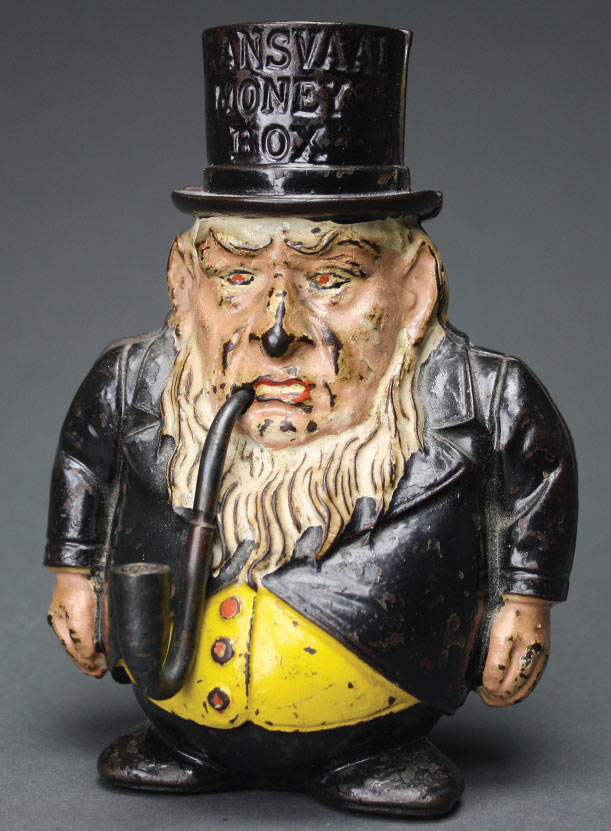
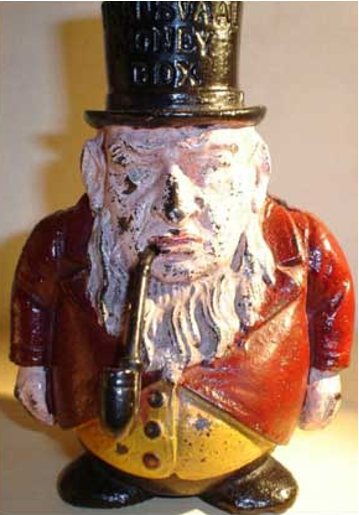
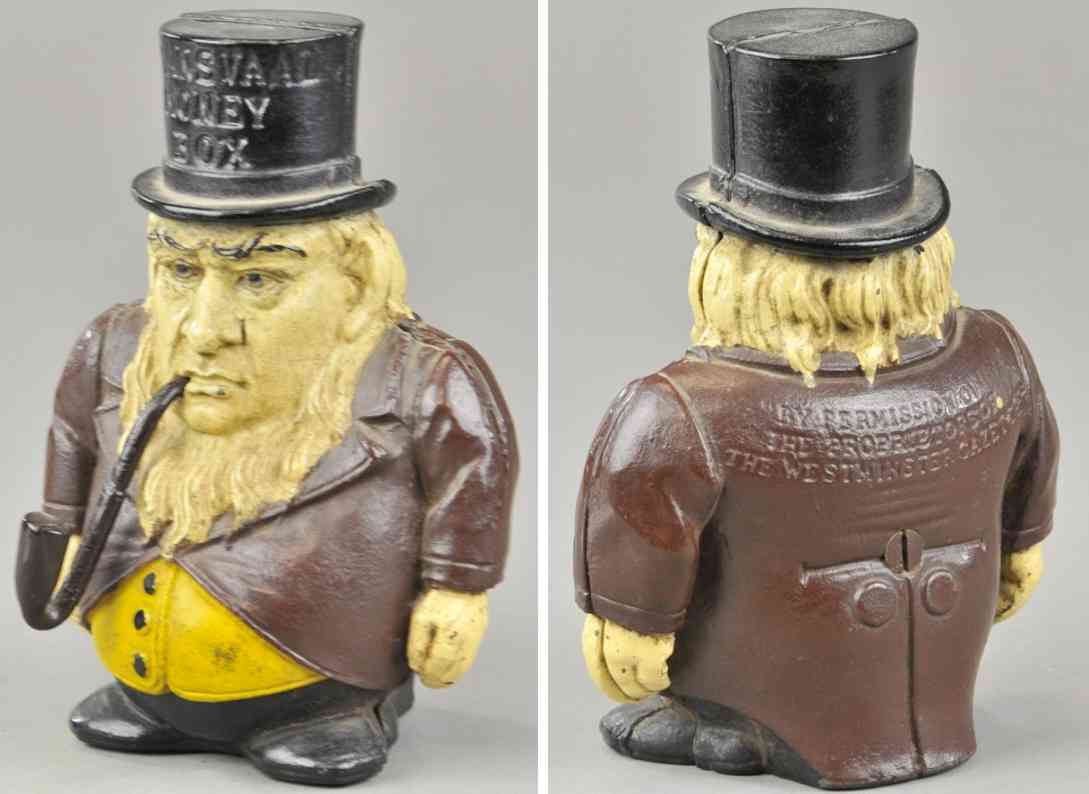

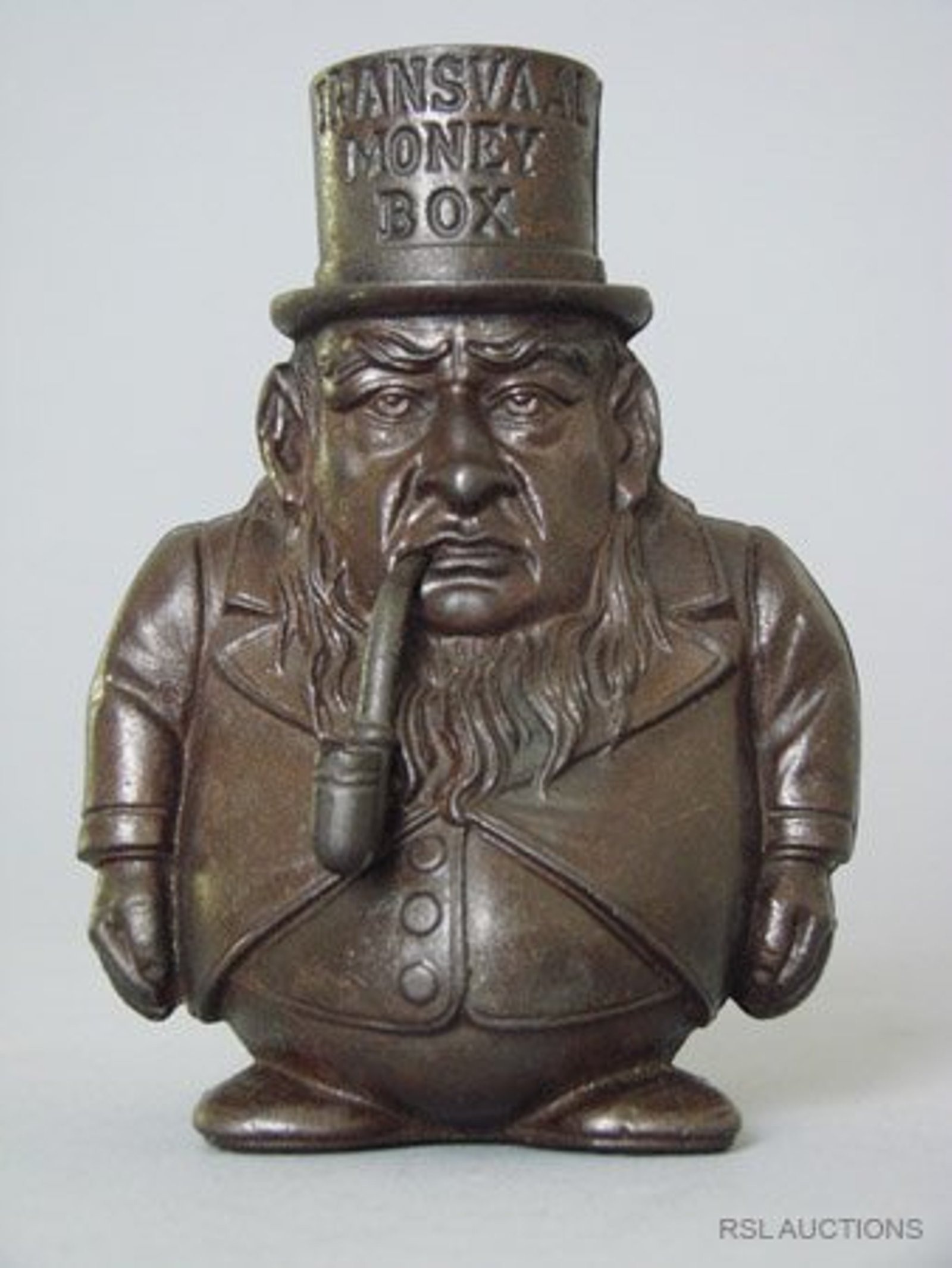
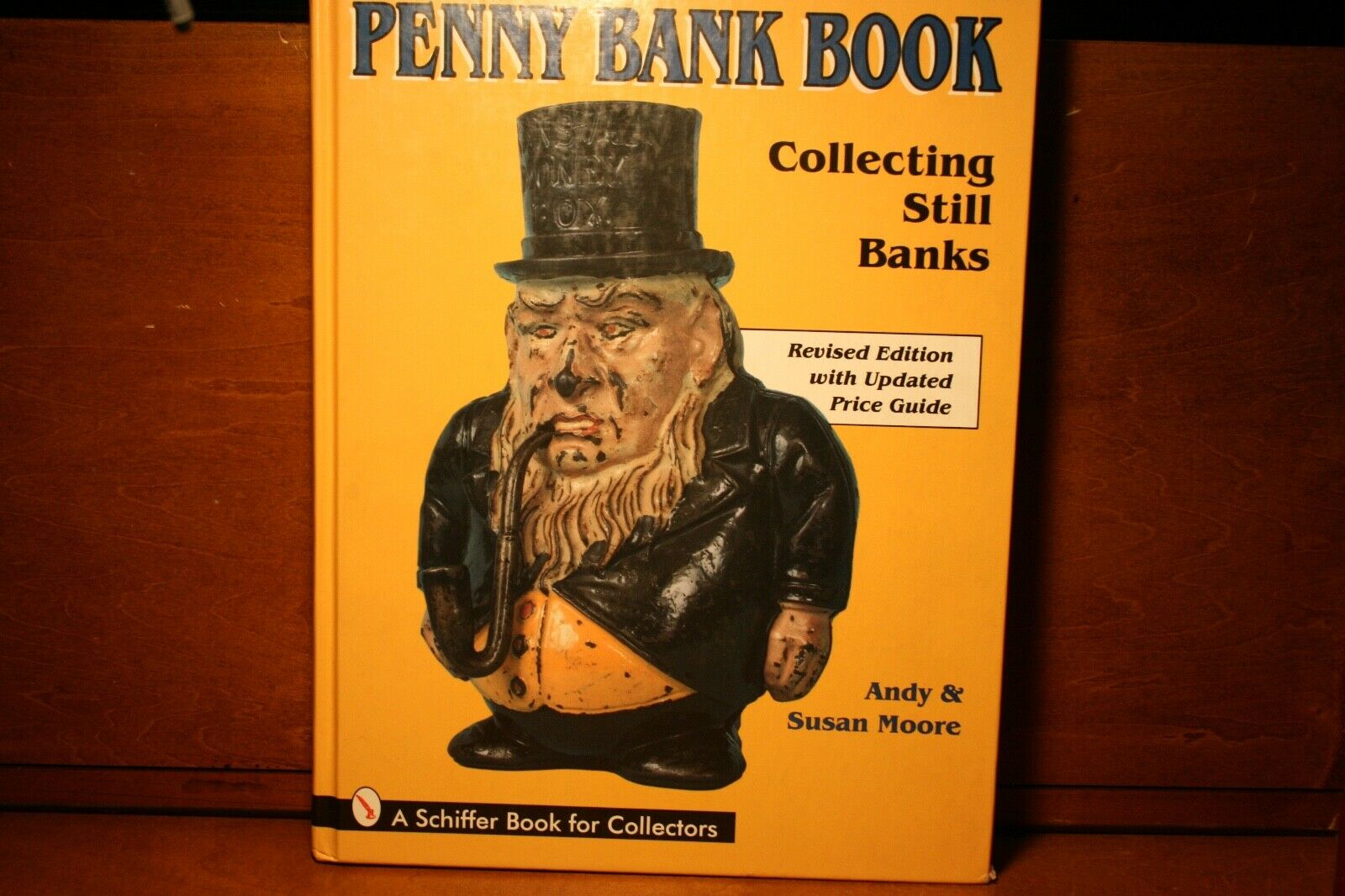

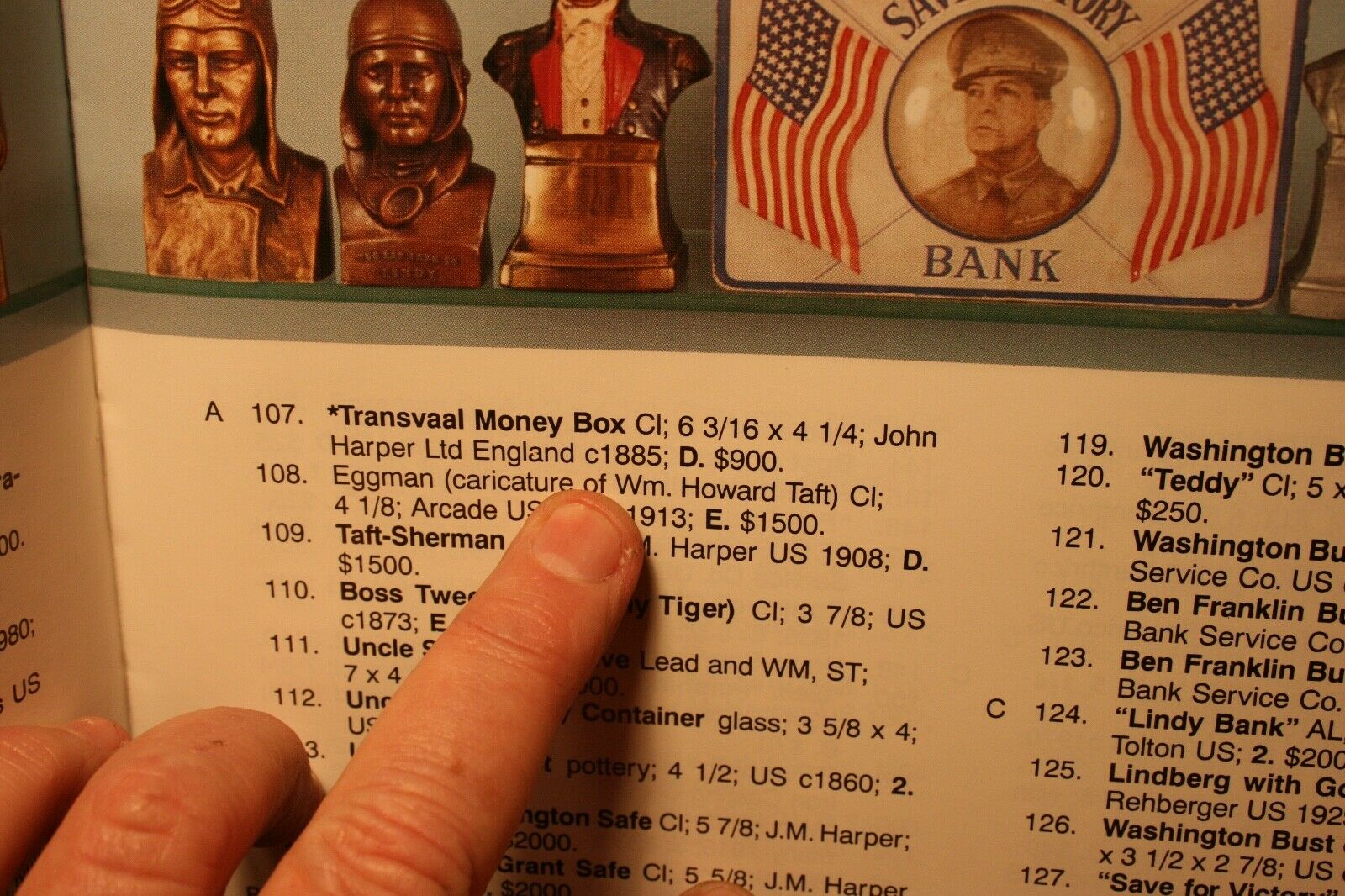
During my research, I also came across what is said to be the original box that the Harper banks were sold in. However, this statement has not been validated. Pictures of the box have been provided below.


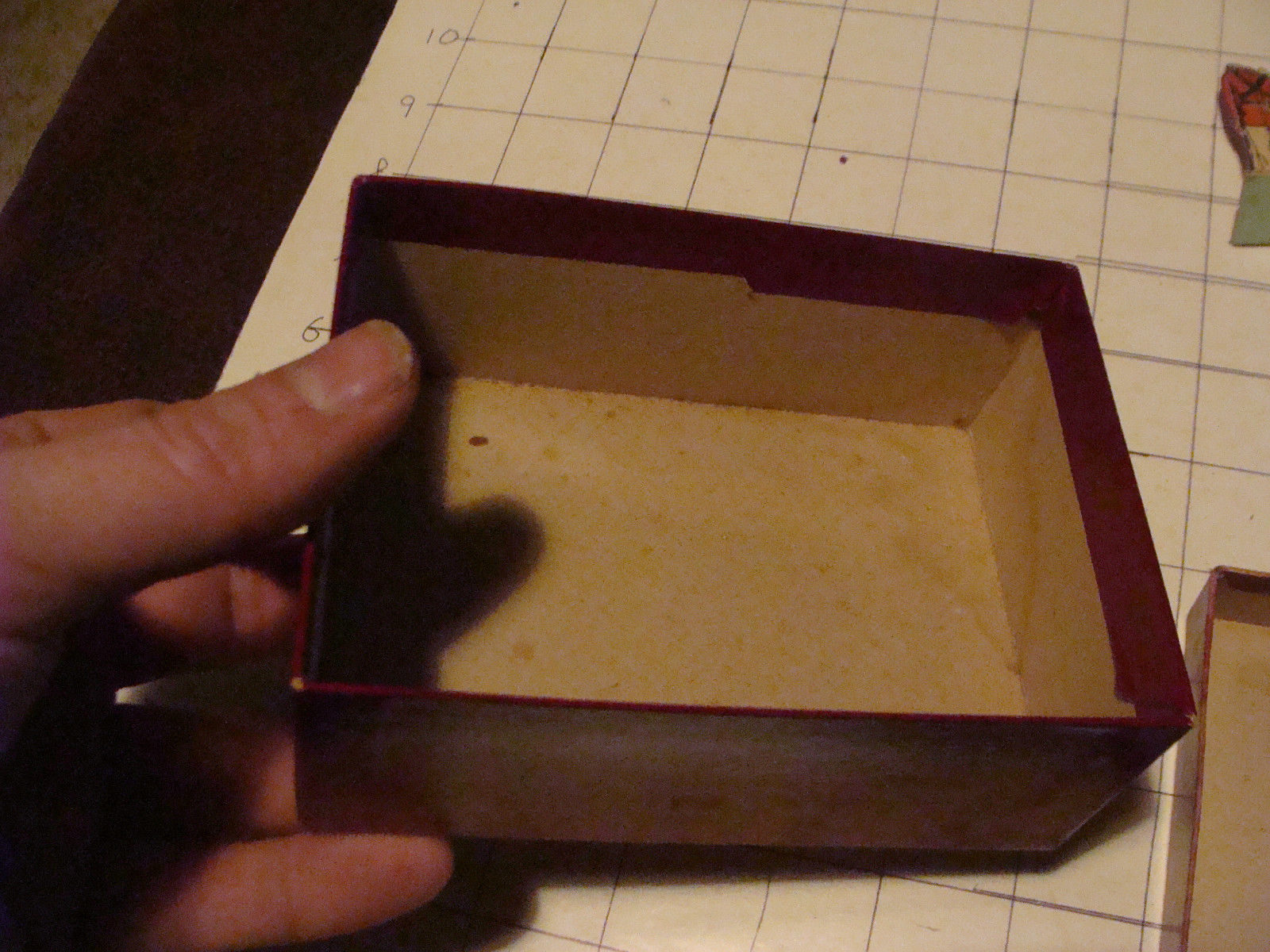
The original Harper money boxes are very scarce and are highly prized by vintage money box collectors, however, there are the alternative “Gazelie” banks that have grown in popularity over the past century. Some collectors seem to draw a line in the sand here. If it doesn’t say Gazette, it’s not Boer War, it’s not an authentic antique, and it’s a “fake.”
Contrary to popular belief, the Gazelie banks were made around the same time as the Harper Banks. Other manufacturers saw the original Harper banks and identified a market that Harper was missing. And so they made their own semi-mechanical Transvaal Money Boxes – making the pipe thicker and movable. Whenever a coin is deposited into the top of Kruger’s hat, a lever makes his pipe jiggle up and down, surely a delight for kids of all ages!
The inscription on the back was also slightly altered to “By permission of the proprietors of the Westminster Gazelie” for the exact same reason John Harper clearly printed Gazette on their banks. The new manufacturers didn’t want to have any copyright problems.
Below is a slide show of the Gazelie Transvaal Money Boxes.
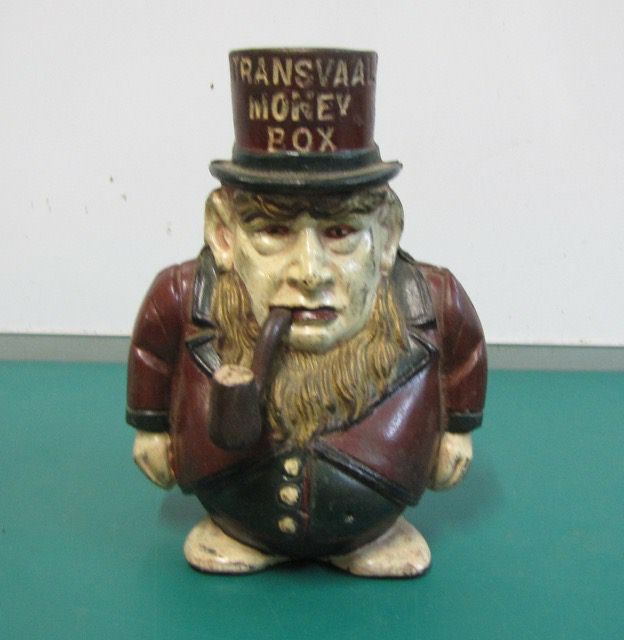
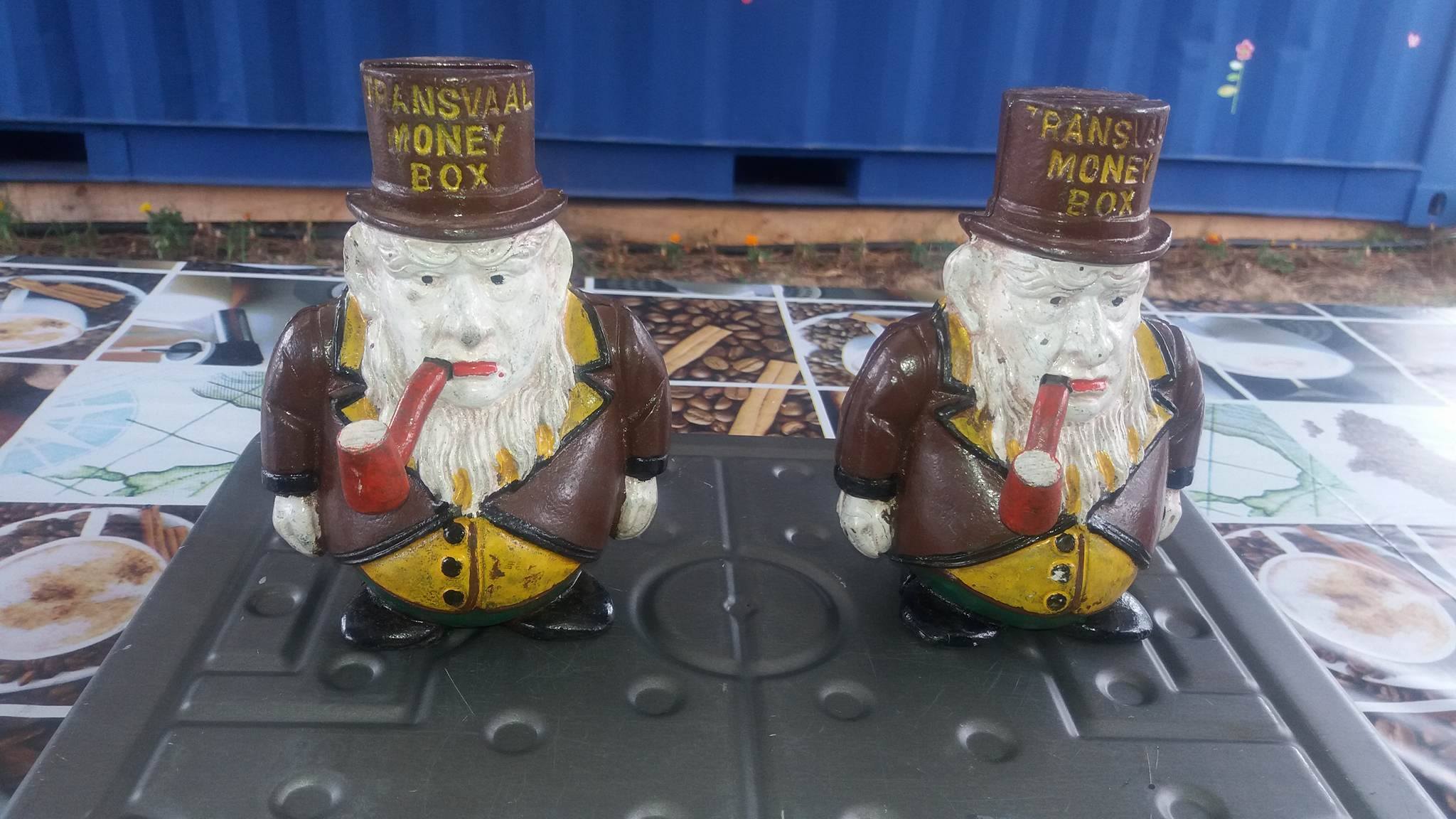
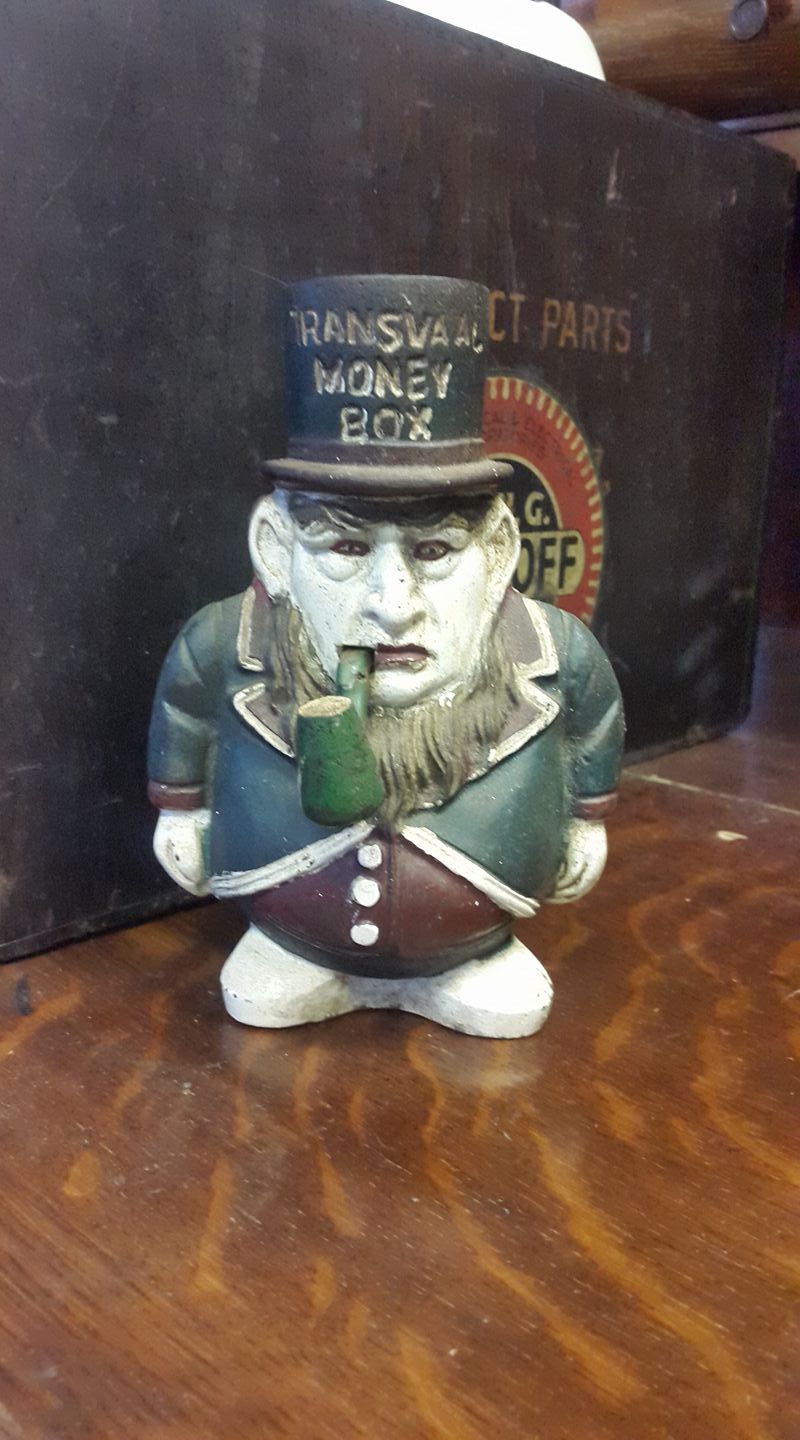
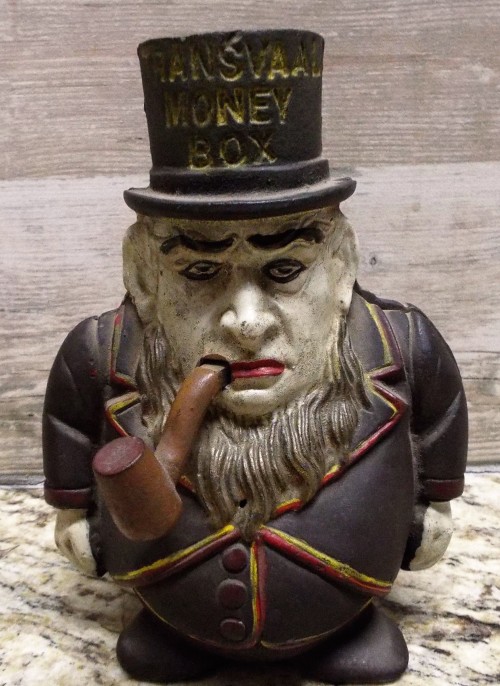
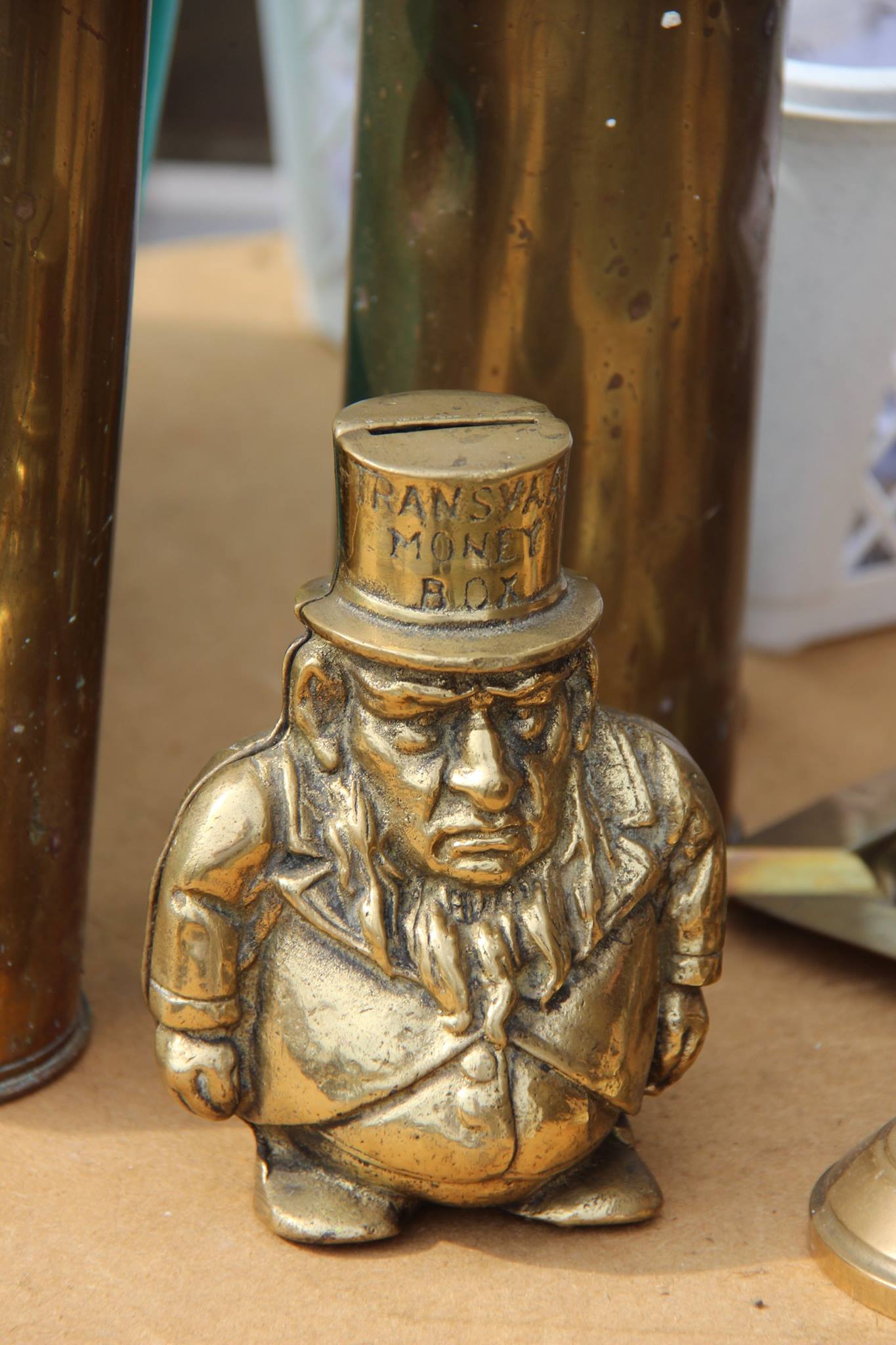
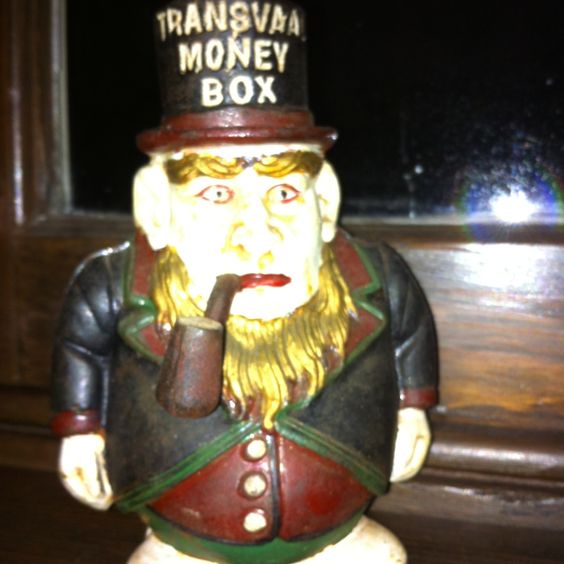

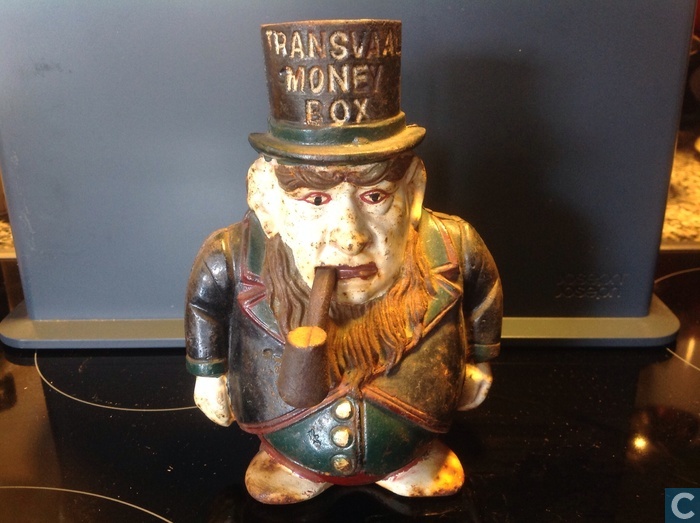
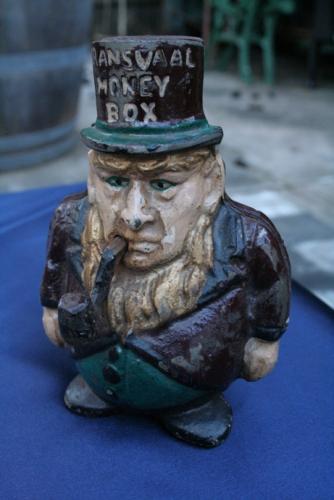
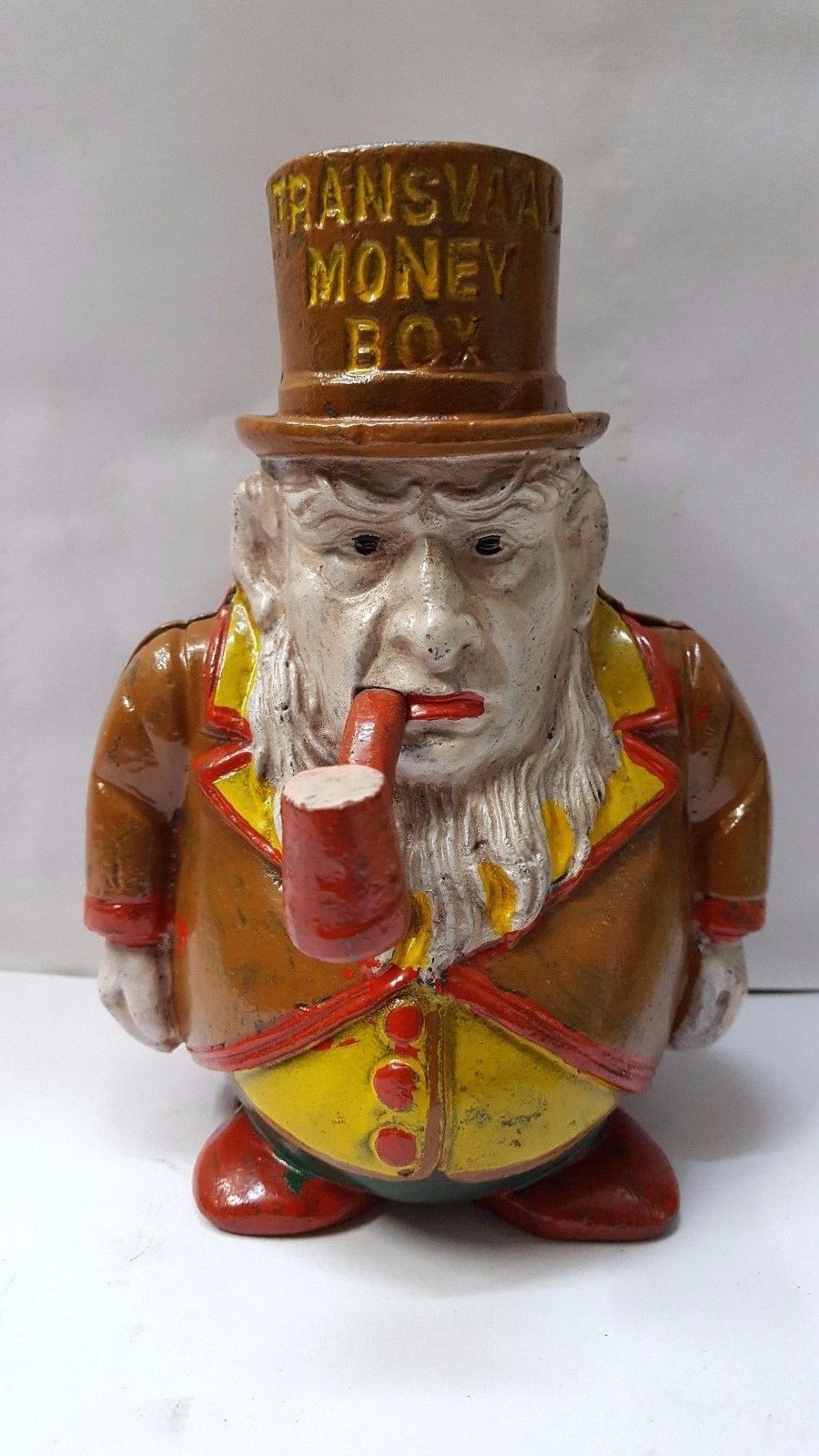
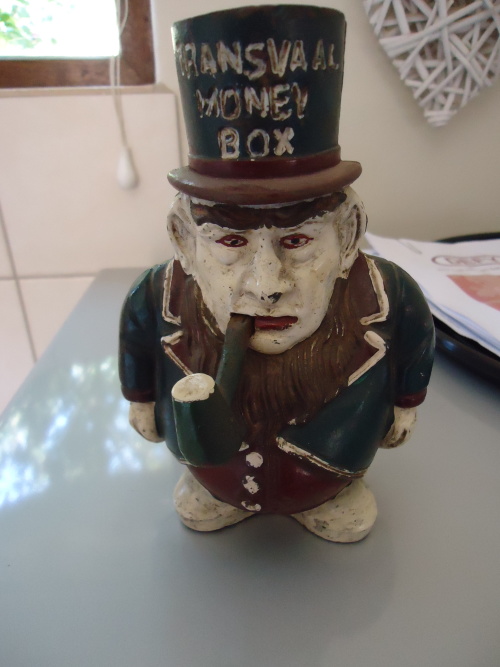
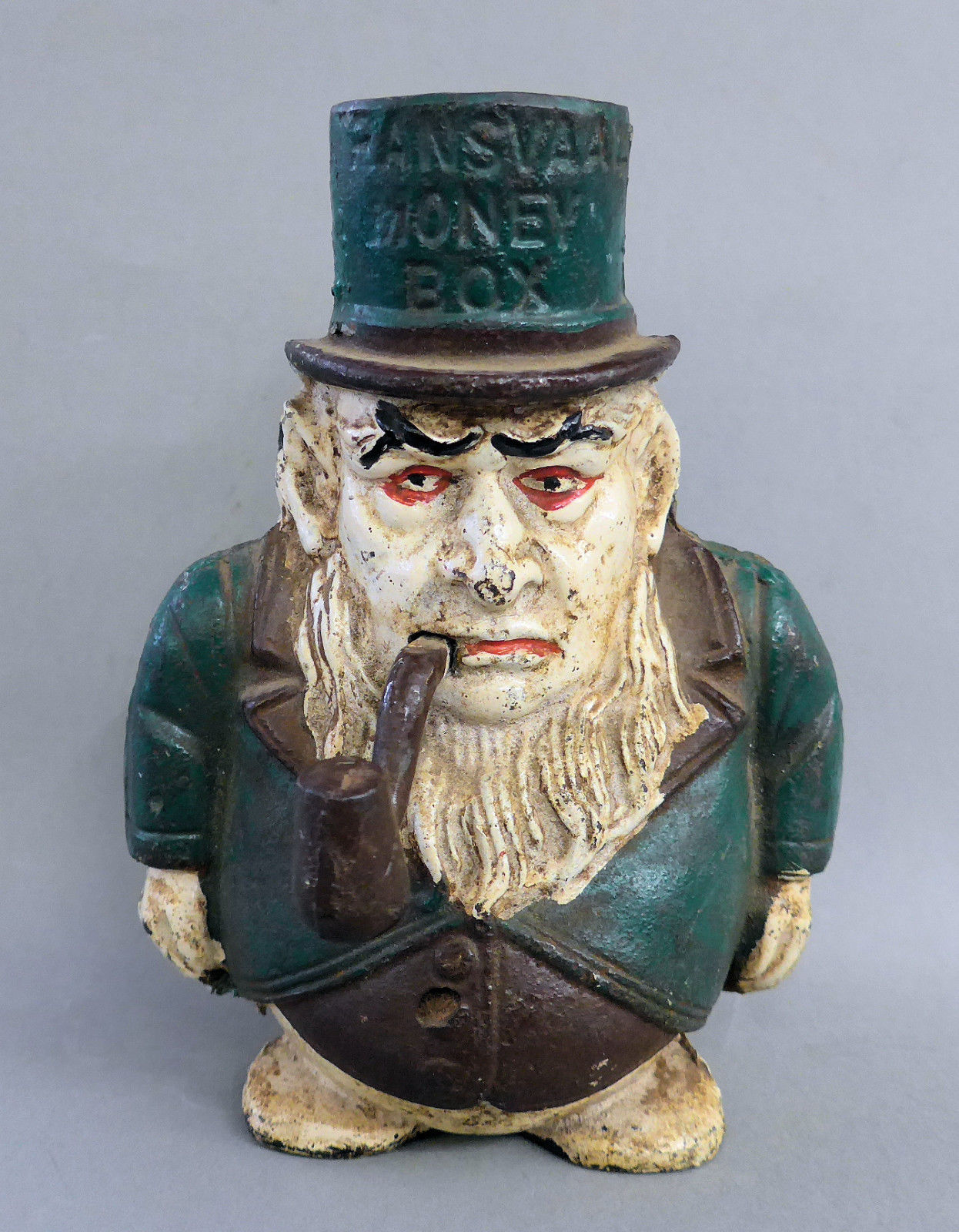

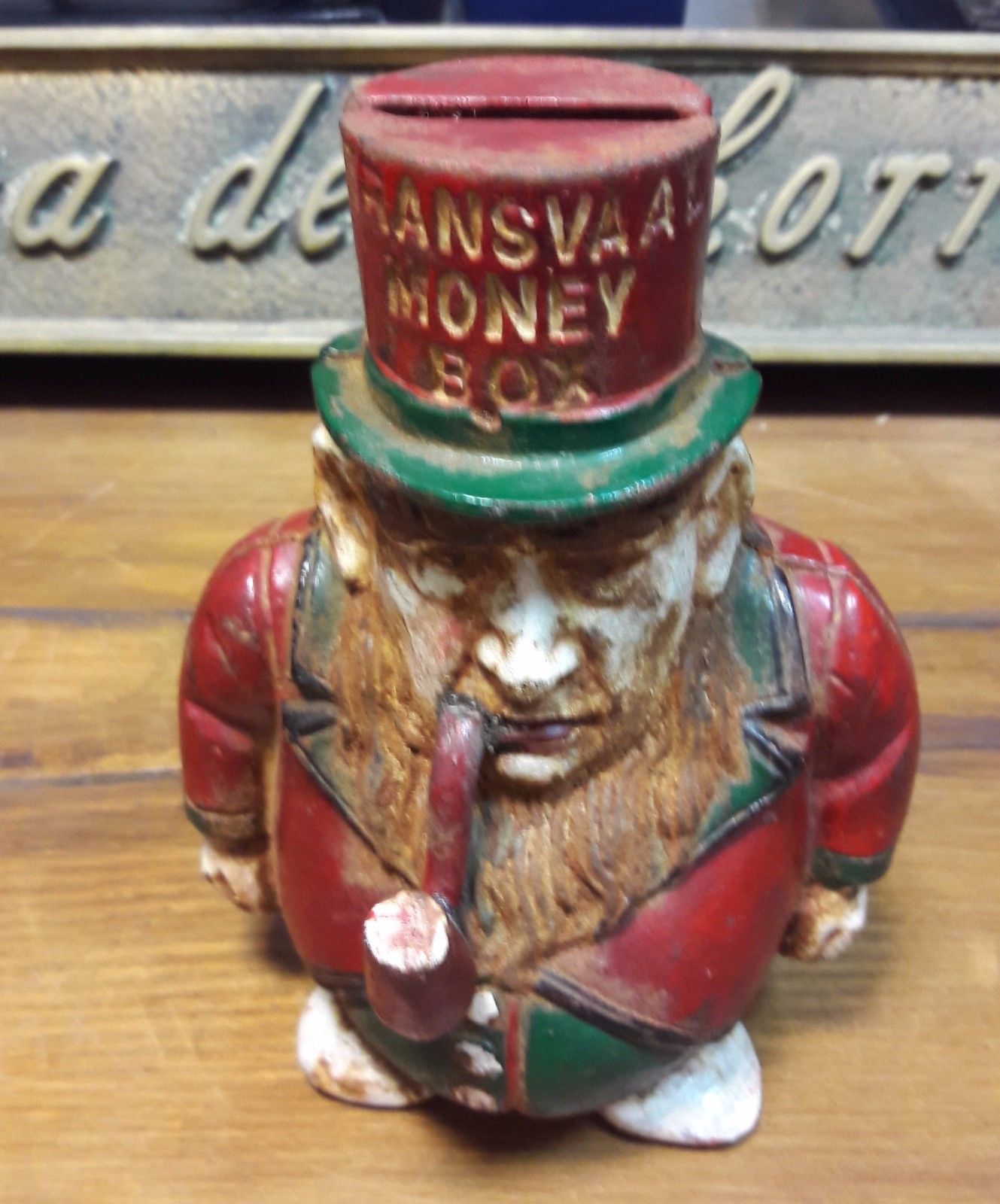
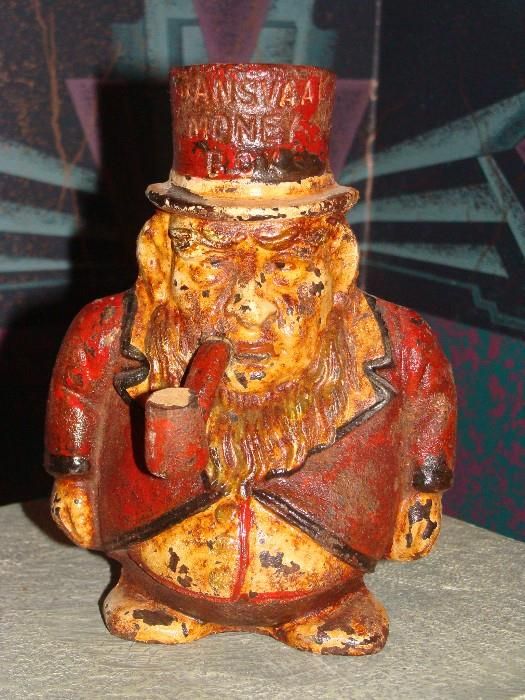

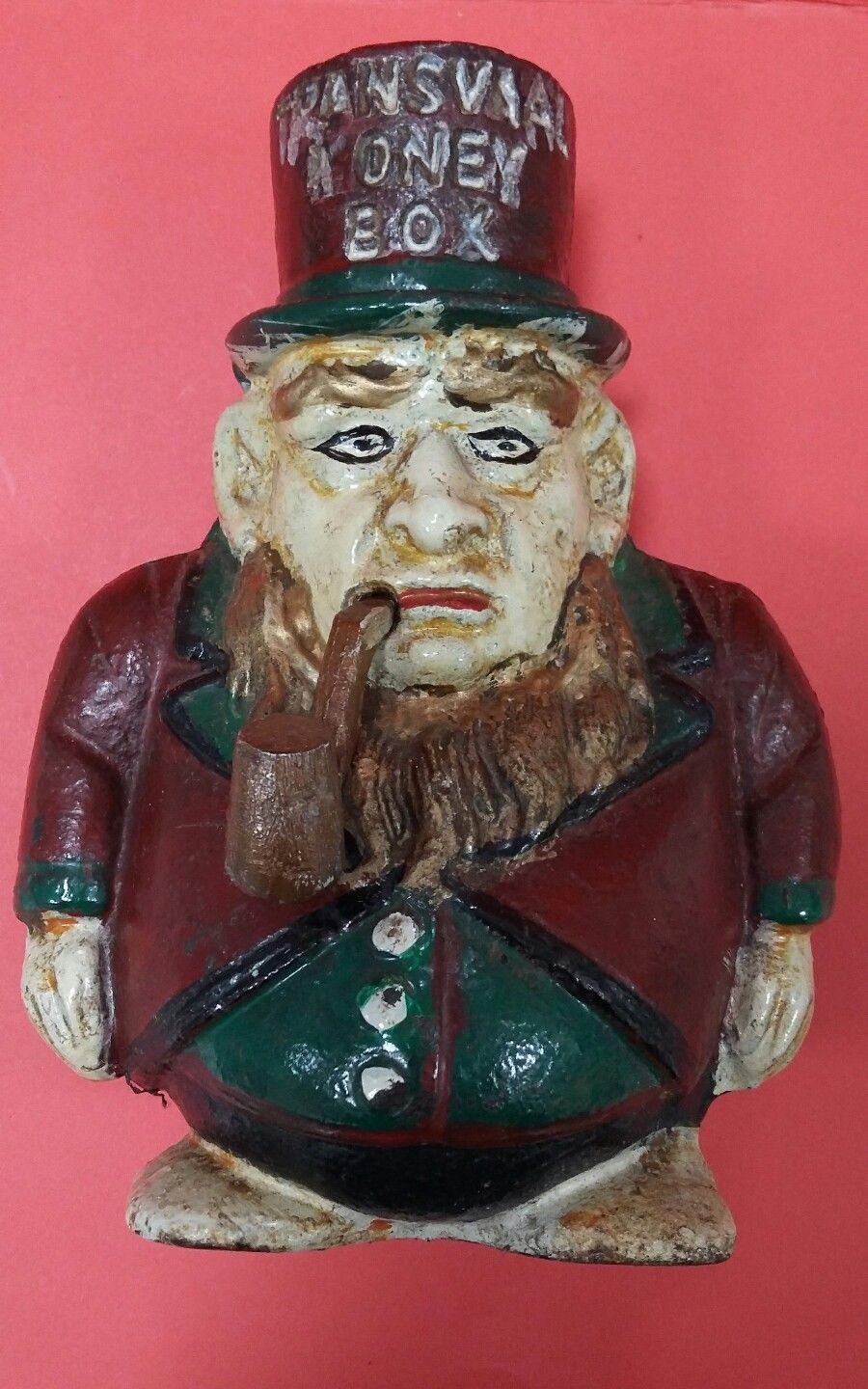

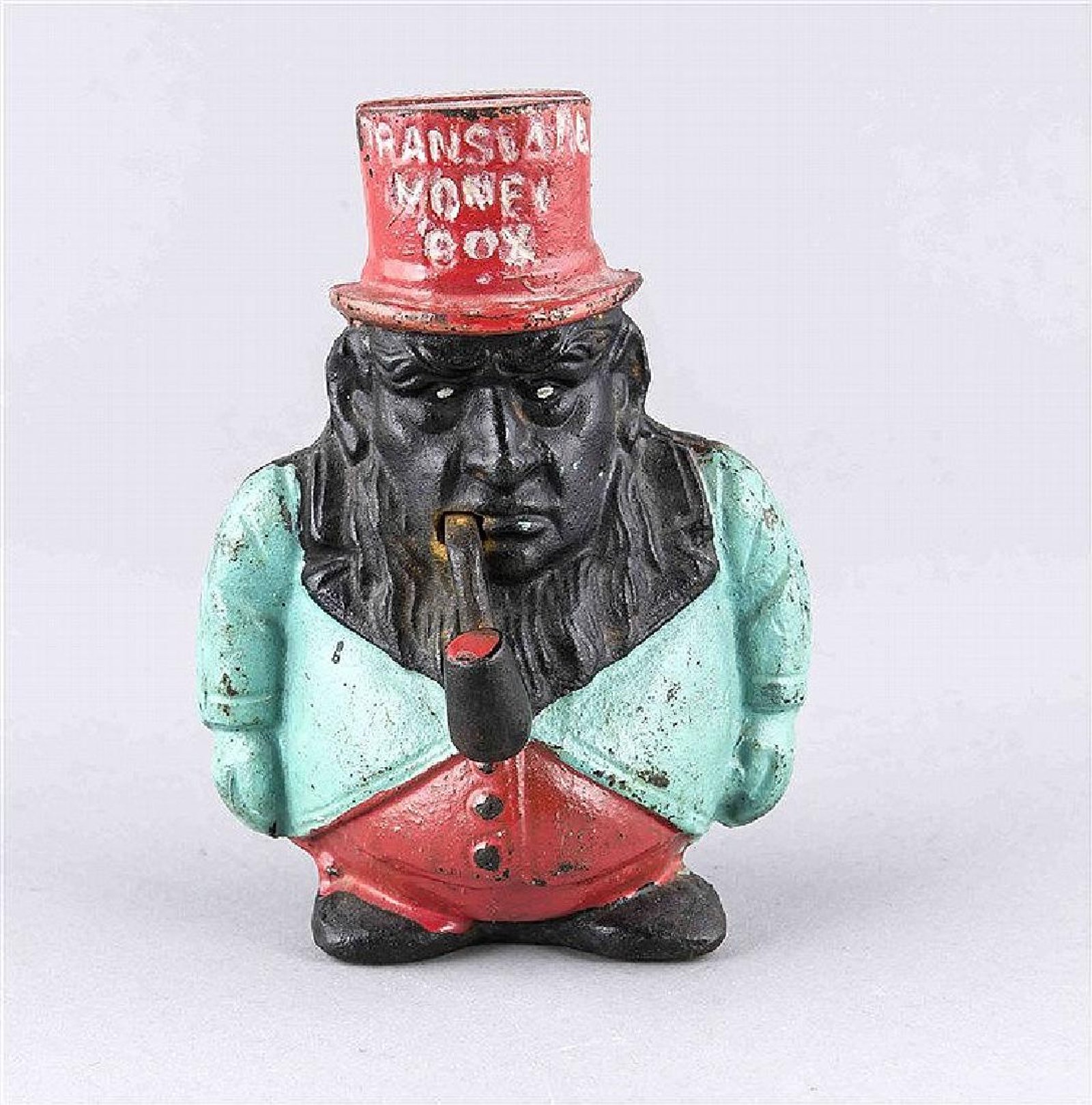
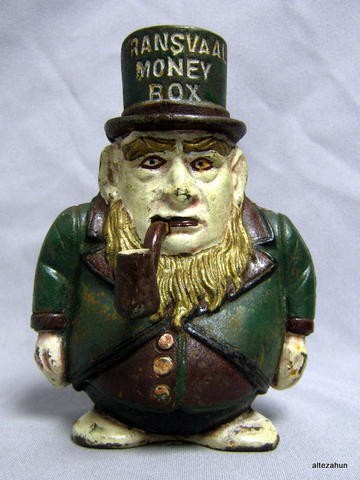



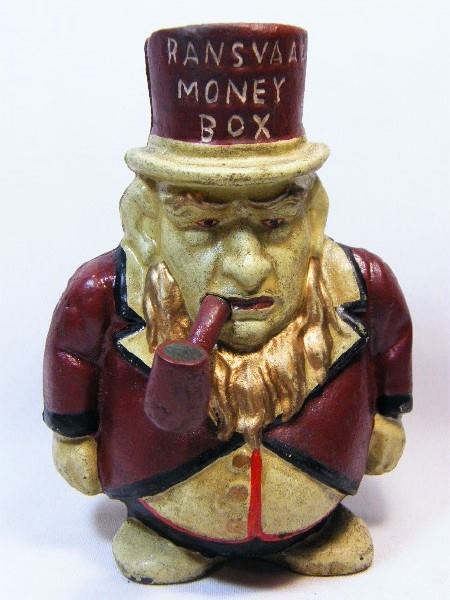
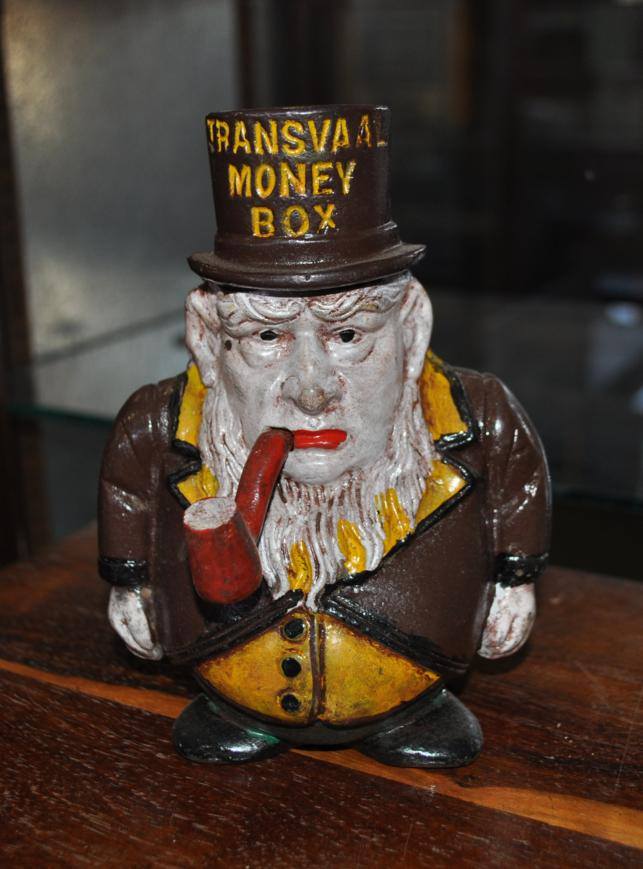
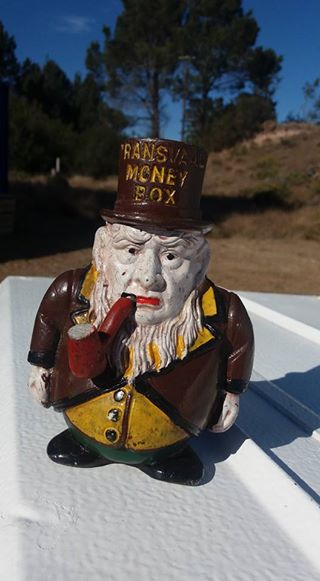





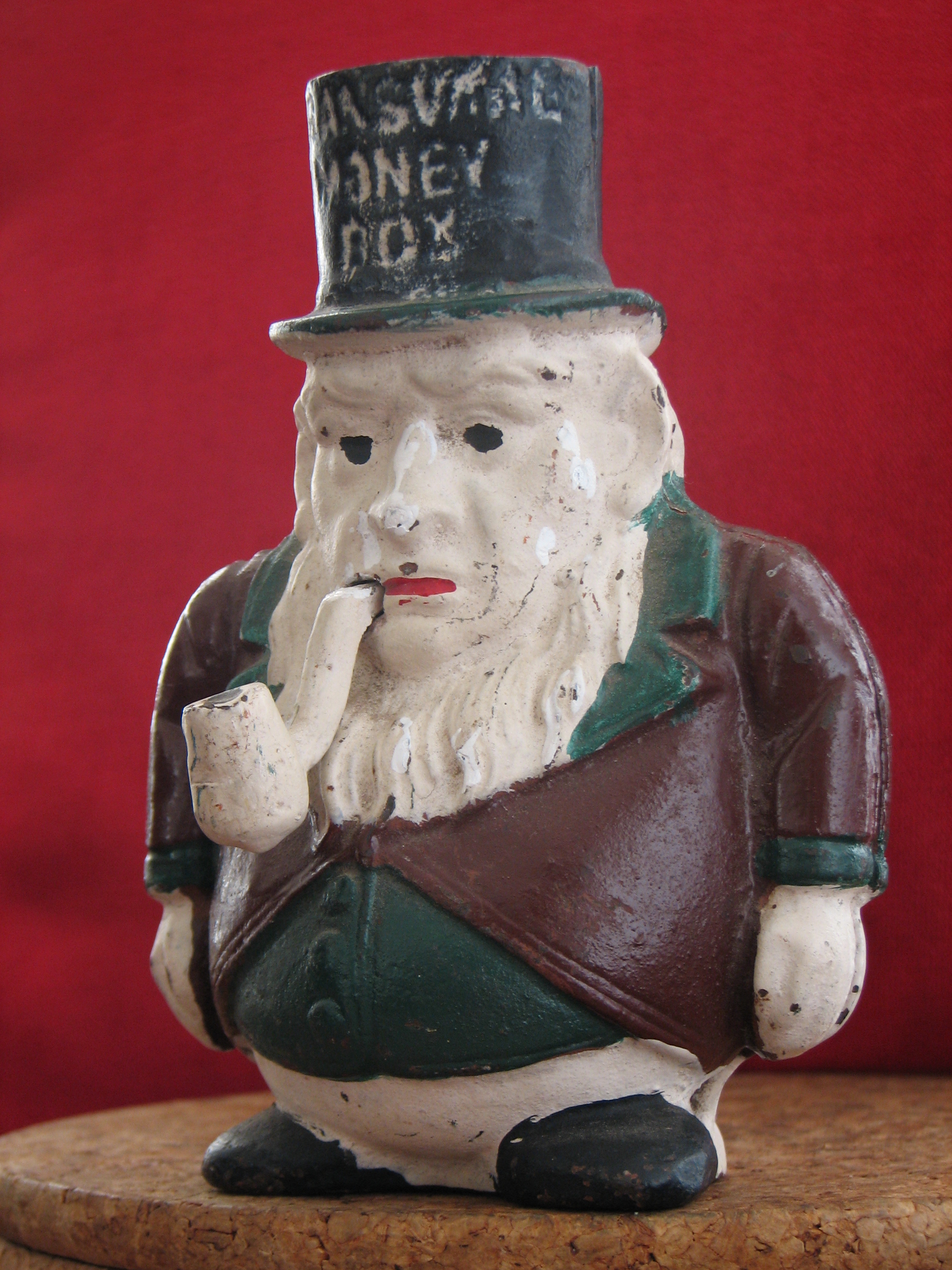
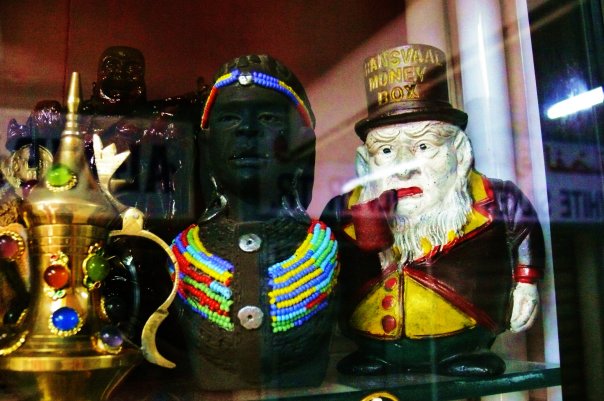
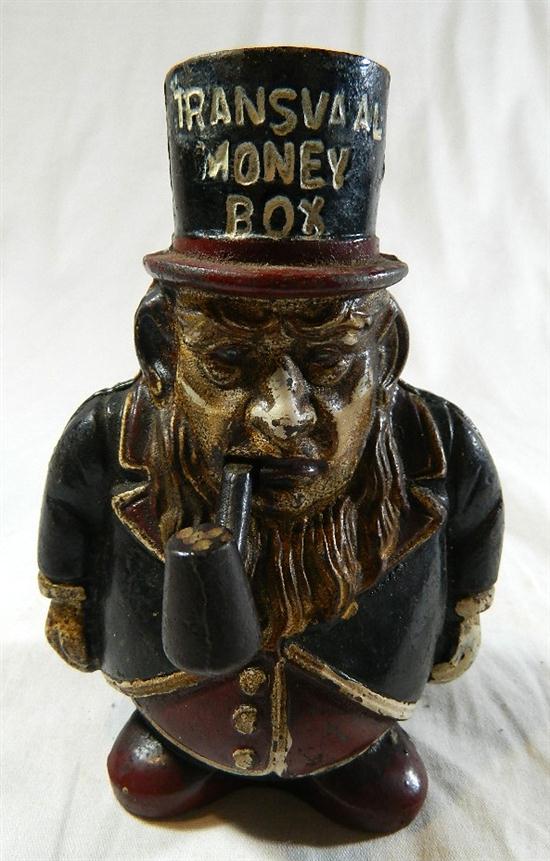


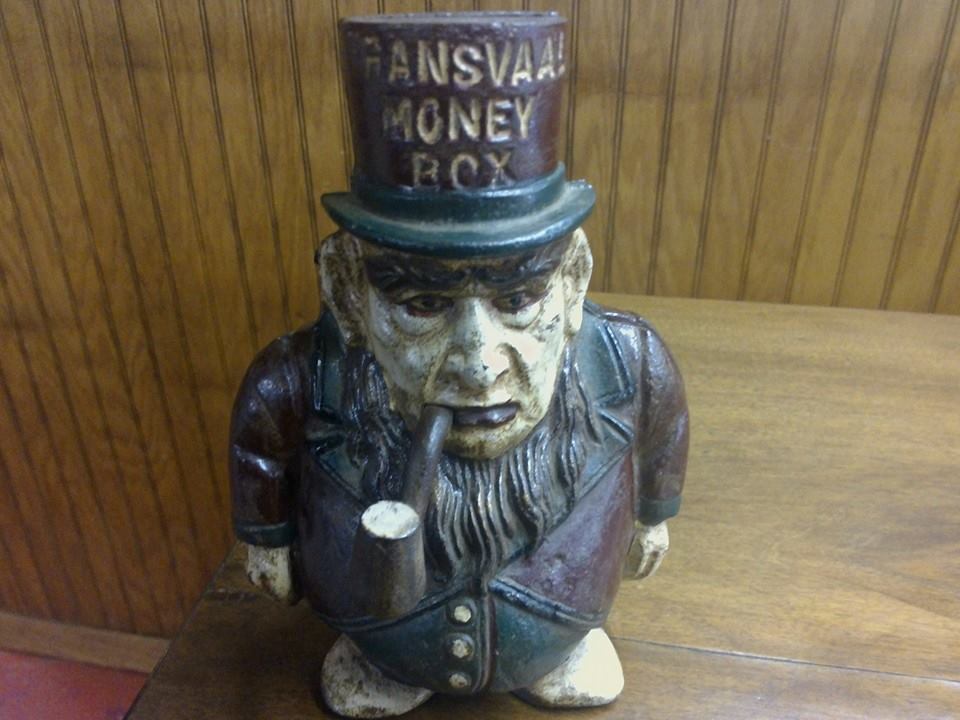

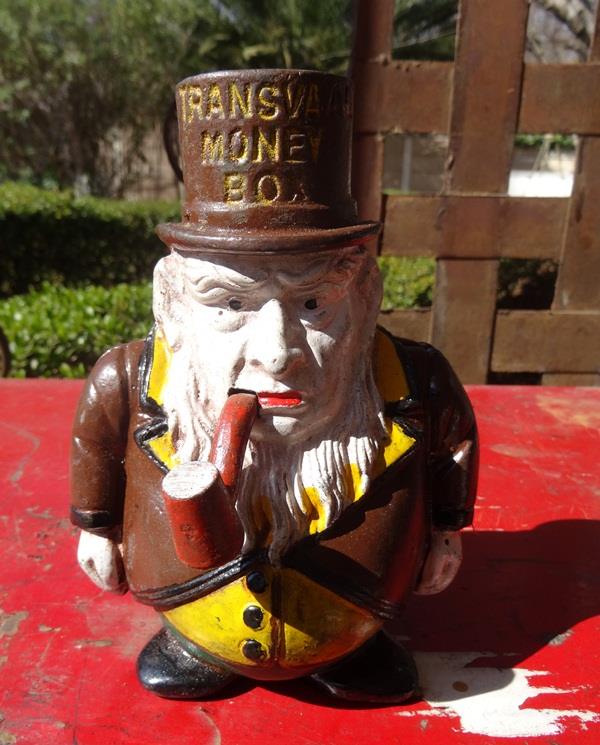

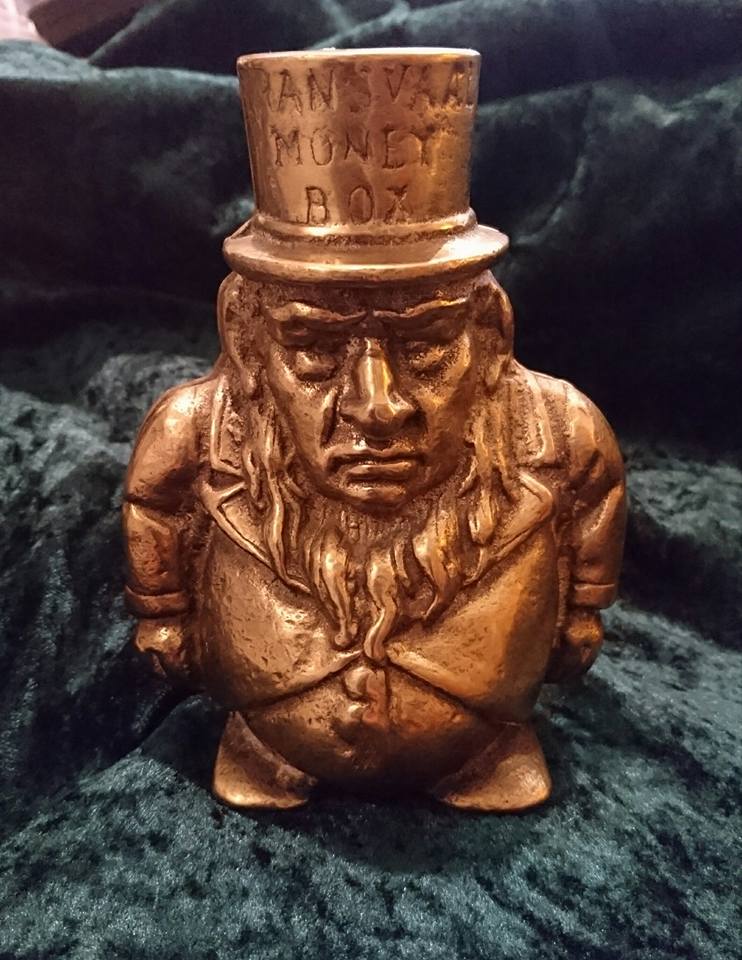
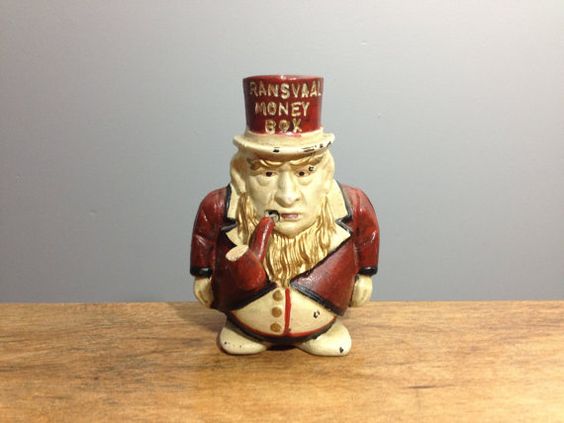
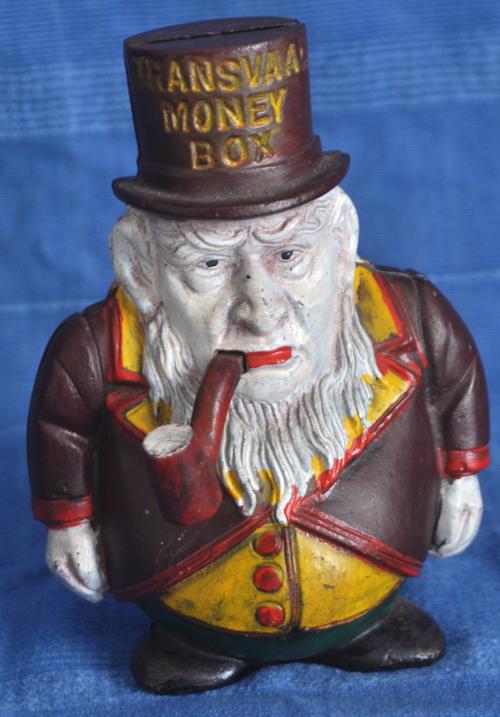

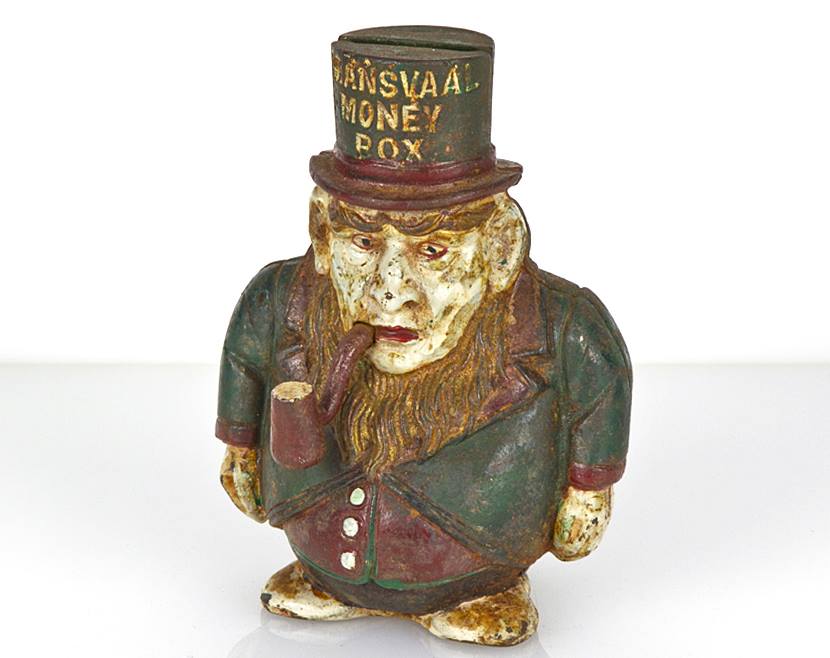
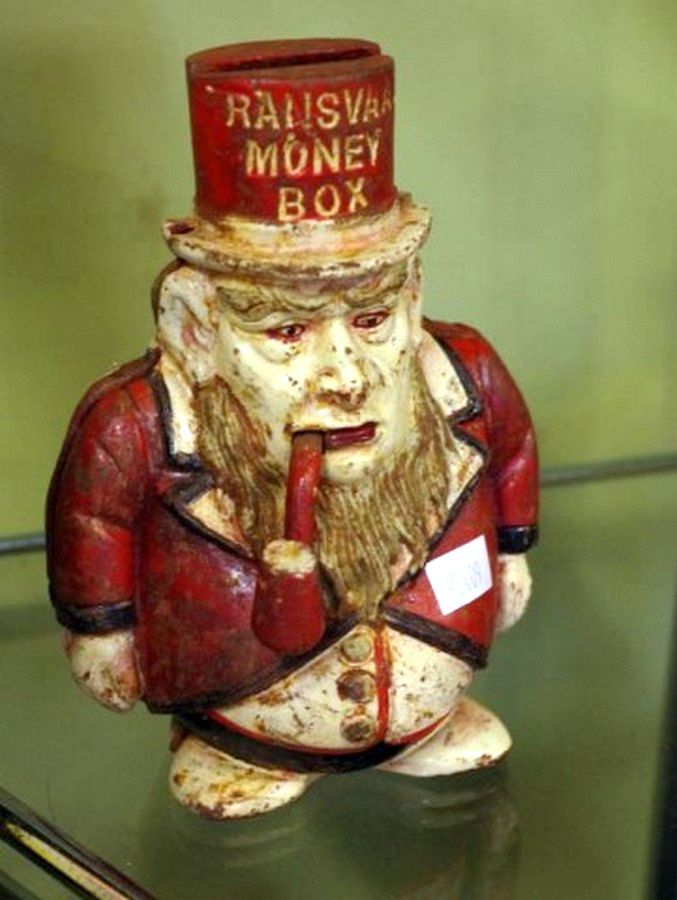
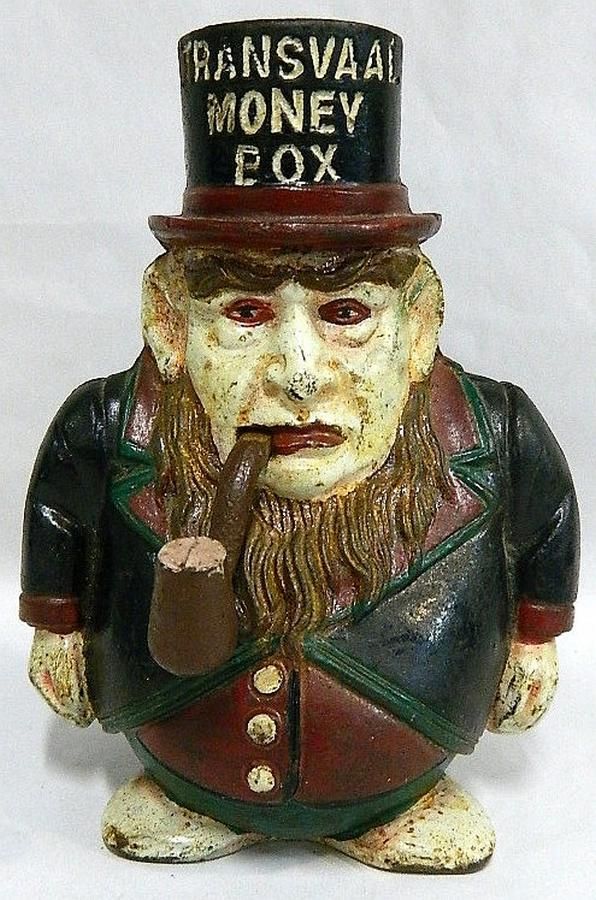
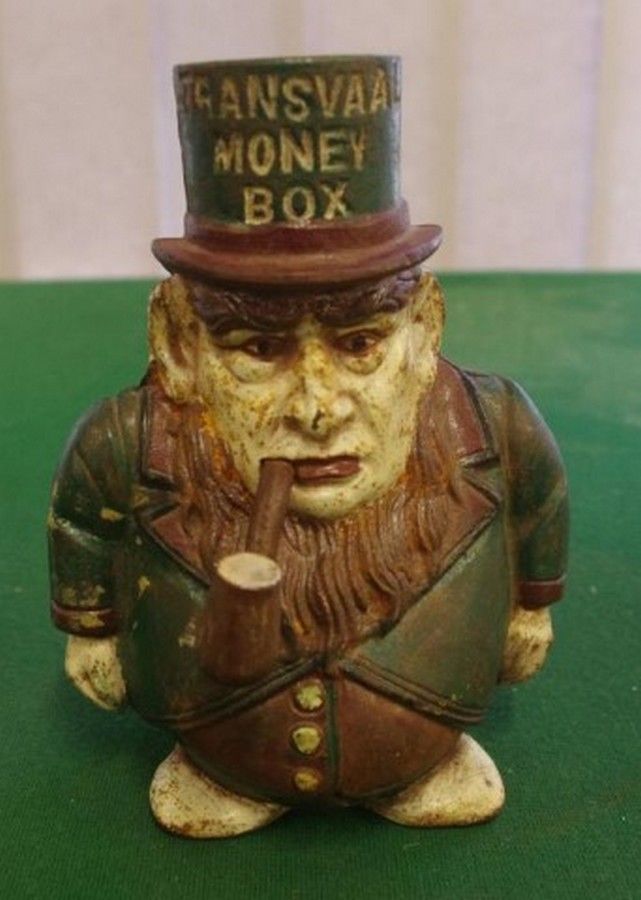
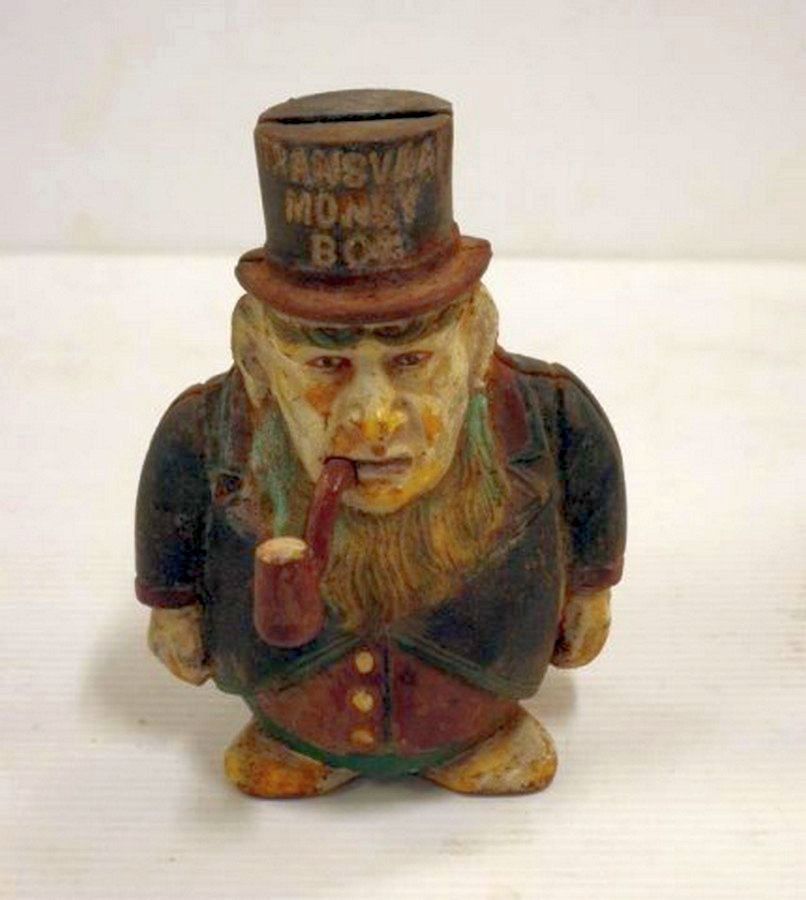




In some instances, Kruger has a distinctly Irish look about him and these money boxes are often mistakenly sold as Cast Iron Leprechauns. I suppose there is some sort of irony here, since Leprechaun’s have their pot of gold and Paul kruger had his hoard of gold known as the Kruger Millions.
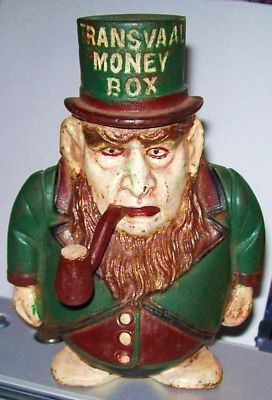
The main differences between the original Harper money box and the Gazelie money box are the following:
- The pipe – The Harper money boxes have non-mechanical/ fixed pipes that are long and slender and point downwards. Whereas the Gazelie money boxes have semi-mechanical/ movable pipes that are thicker and point outward instead of down.
- The wording on the back – The Harper money boxes state Westminster “Gazette” on the back. Whereas the Gazelie money boxes state Westminster “Gazelie” on the back.
- Quality of the casting – The Harper money boxes seems to be a finer quality casting than the Gazelie money boxes. The inscriptions on the hat and back are more prominent and finely engraved on the Harper money boxes. The Harper money boxes also show a three line crease on the middle left hand side of Kruger’s jacket that is not found on the Gazelie money boxes.
- The holes underneath – The Harper money boxes have 18 holes in a clearly repeatable pattern. Whereas the Gazelie money boxes have 7 to 9 holes mostly drilled in random patterns.
- The price – The Harper money boxes are extremely rare and can fetch a hefty amount on auction. The Gazelie money boxes are more common, and although these are not considered to be originals, they are still antiques which hold value among cast iron/ money box collectors.
According to Kovels website, “Banks of metal have been made since 1868. There are still banks, mechanical banks, and registering banks (those that record the total money deposited, on the face of the bank). The value of a bank is not determined solely by age. Rarity and condition also determine value. Many old iron or tin banks have been reproduced since the 1950s in iron or plastic.”
Whenever dealing with highly sought after antiques or collectibles, there will always be modern replicas out there. Through my research, I came across a company in South Africa called Gold Reef City Mint that sells modern Transvaal Money Box reproductions cast from zinc alloy for R750. The company has the original “gazette” mould for the money boxes, which is very surprising. But as you can see from the pictures below, the mould they have for the pipe is incorrect, as this is the “gazelie” pipe which was a later production by another company. Here are a few examples of these money boxes, one can tell that they are brand new and have no patina or signs of aging.
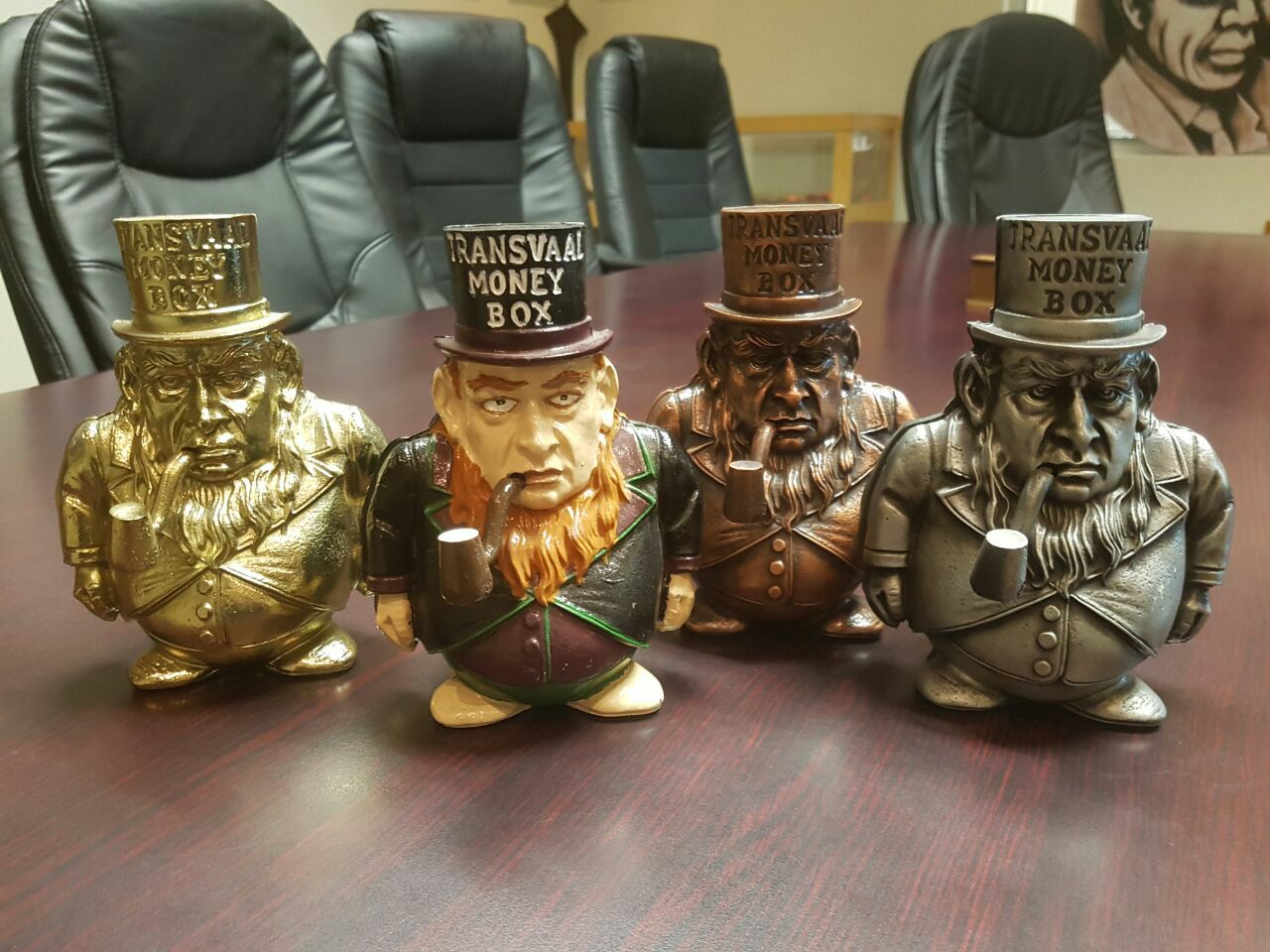
Although Paul Kruger died in 1904 and took with him the known whereabouts of the Kruger Millions, these cast iron money boxes have stood the test of time and will continue to be highly sought after by collectors for many generations to come.
About the Author
For more articles visit Dayne’s Discoveries Blog, browse our online shop, or contact us to share information, stories, or photographs relating to the history of the Transvaal Money Box.

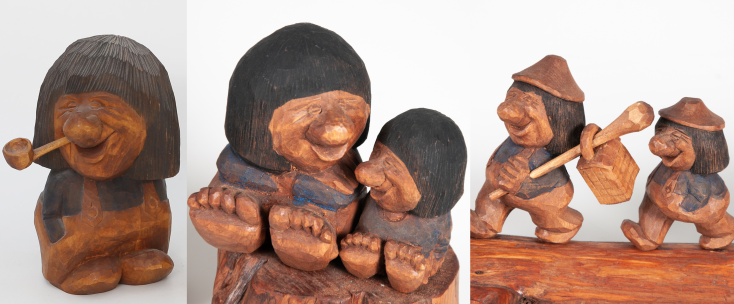
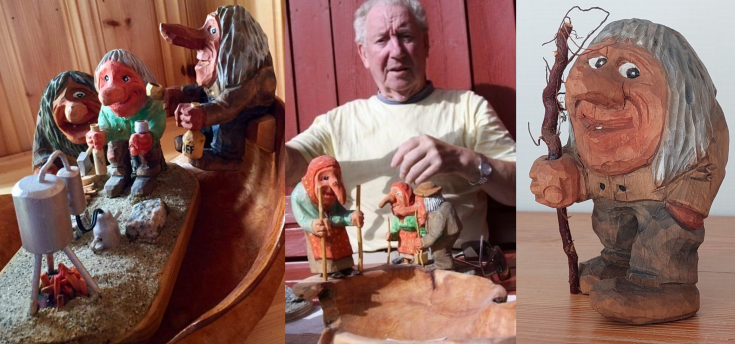
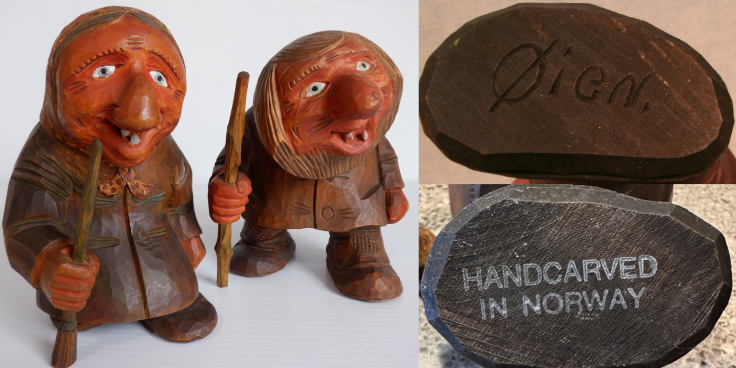
I have what appears a genuine gazelie cast iron money box with great petina in lovely condition I am looking to sell but not sure of value ? thank you for your info Cheers Mel
LikeLike
Very usefull and interesting. I have one. Thank you Sir!
LikeLiked by 1 person